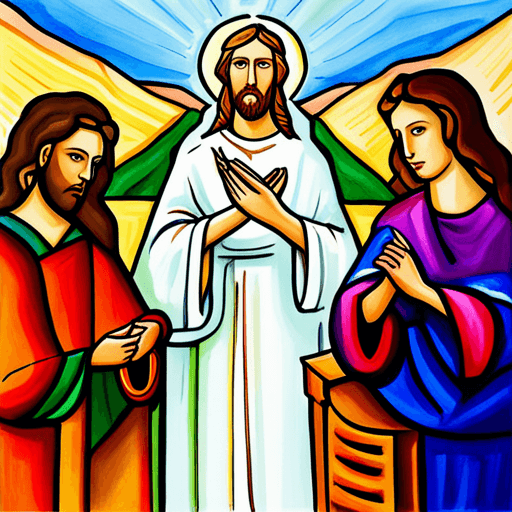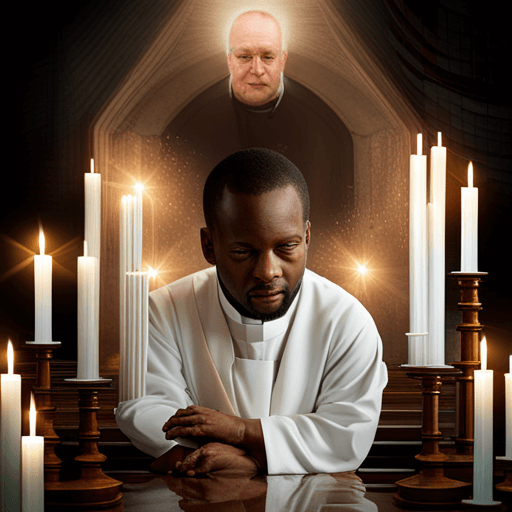Have you ever heard of the Angelus prayer? It is an ancient tradition that has been a part of Catholicism for centuries. This seemingly simple prayer, recited three times a day, holds deep significance and meaning for those who practice it.
In this article, we will explore the origins and history of the Angelus prayer, its structure and meaning, and how you can incorporate it into your daily spiritual practices.
As you delve into the history of the Angelus prayer, you will discover its roots in medieval Europe. It was a way for farmers to pause during their workday and honor Mary’s role in salvation history. Over time, it became a staple in Catholic devotionals as well as an integral part of liturgical worship.
Despite its ancient origins, however, the Angelus still holds relevance today. So whether you are a devout Catholic or simply curious about different faith traditions, read on to learn more about this beautiful prayer practice and how it can enrich your spiritual life.
Origins and History of the Angelus Prayer
It’s fascinating to learn about the origins and evolution of the Angelus prayer. This ancient devotion has been recited by Catholics for centuries, marking key moments in the day when they pause to reflect on their faith.
The name ‘Angelus’ comes from the Latin word for ‘angel,’ and it is believed that this tradition began in medieval Europe as a way to honor the Annunciation, or the moment when the angel Gabriel appeared to Mary.
Over time, the prayer evolved into its current form of three Hail Marys and a short verse. It became associated with ringing bells at noon and 6 pm, which signaled everyone to stop what they were doing and say the Angelus together.
Today, many people still practice this tradition as a way to connect with their spirituality throughout their busy days. Despite its ancient roots, the Angelus continues to be an important part of Catholic culture around the world.
Significance of the Angelus in Catholicism
You may not realize it, but the three daily moments of pause and reflection that the Catholic Church celebrates have a significant impact on shaping your spiritual life.
One of these moments is the Angelus prayer, which is recited every morning, noon and evening. This devotion and contemplation allows Catholics to reflect upon their faith, connect with God and deepen their relationship with Mary.
The significance of the Angelus lies in its connection with Marian devotion. Through this prayer, Catholics honor Mary’s role in the incarnation of Jesus Christ. It also reminds us to be grateful for her intercession in our lives.
By reciting this prayer three times a day, we are reminded to take a break from our busy lives and focus on our spiritual well-being. The Angelus encourages us to contemplate on our own personal relationship with God through Mary’s guidance as we ask for her help in achieving spiritual growth.
The Structure and Meaning of the Angelus Prayer
As a Catholic, you may find it helpful to understand the structure and significance of the daily moments of devotion in order to deepen your spiritual connection with God.
The Angelus prayer is one such devotional practice that has been passed down through generations. The prayer mechanics of the Angelus involve reciting three Hail Marys, followed by a short verse and concluding with a Glory Be. This pattern is repeated three times in honor of the Holy Trinity.
But what are the devotional benefits of reciting this ancient prayer? For starters, it provides an opportunity for Catholics to pause from their busy lives and reflect on their faith. By taking a few moments each day to pray the Angelus, one can cultivate a deeper sense of gratitude and appreciation for God’s blessings in their life.
Additionally, reciting this prayer at specific times during the day (such as noon or 6 pm) helps to create a sense of rhythm and routine in one’s spiritual life.
Overall, understanding the structure and meaning behind this traditional Catholic prayer can help individuals connect more fully with their faith on a daily basis.
Incorporating the Angelus into Daily Spiritual Practices
Incorporating daily moments of devotion, such as reciting the Hail Marys and Glory Be with a short verse in between, can help Catholics establish a consistent spiritual routine. One way to enhance this practice is by adding an Angelus meditation during midday.
The Angelus prayer encourages us to pause from our daily activities and reflect on the mystery of God’s incarnation. By incorporating silence into this practice, we can allow ourselves to be present in the moment and connect with God on a deeper level.
During your midday break, find a quiet space where you can sit comfortably and begin your Angelus meditation. As you recite the prayer, take time to meditate on each phrase and let its meaning sink in. Then allow yourself to sit in silence for a few minutes before going back to your tasks for the day.
This simple practice will not only help you develop spiritual discipline but also bring peace into your busy life.
The Continuing Relevance of the Angelus in Modern Times
One can see the enduring importance of pausing for moments of spiritual reflection amidst the chaos and busyness of modern life. The Angelus, with its roots in ancient tradition, provides a meaningful way to do just that.
Beyond personal spiritual practices, the Angelus has had a cultural impact as well. In today’s diverse society, the Angelus serves as a bridge for interfaith dialogue. Its universal message of prayer and gratitude transcends religious boundaries and allows people from different faiths to come together in a shared moment of reflection.
In this way, the Angelus continues to be relevant in modern times by promoting understanding and unity among individuals and communities alike.
Frequently Asked Questions
Is the Angelus prayer exclusive to Catholicism or is it practiced in other Christian denominations as well?
If you’re wondering whether the Angelus prayer is exclusive to Catholicism or practiced in other Christian denominations, you’ll be interested to know that while it has its roots in the Catholic tradition, it has also been adopted by some Anglicans and Lutherans.
The significance of the Angelus prayer lies in its focus on the mystery of incarnation and how we are called to respond to God’s invitation. In modern times, this ancient practice can serve as a reminder for us to pause amidst our busy lives and reflect on our relationship with God.
Whether you come from a Catholic background or not, incorporating the Angelus prayer into your spiritual routine can provide a sense of connection and belonging within a larger community of believers.
What are some common misconceptions about the Angelus prayer?
Misconceptions about the Angelus prayer abound due to a lack of understanding of its history, interpretations, and significance. Many people assume it’s exclusive to Catholicism, when in reality, it’s practiced by other Christian denominations as well.
Others mistakenly believe that the prayer is only meant to be said at specific times of day or that it must be recited in Latin. However, the true meaning and purpose of the Angelus lies in its reflection on the Incarnation and the message of hope and redemption it brings.
By taking a few moments each day to contemplate this profound mystery, we can deepen our spiritual connection with God and find renewed strength for our daily lives.
Are there any variations or adaptations of the Angelus prayer in different cultures or regions?
When it comes to the Angelus prayer, you may be surprised to learn that there are different variations and cultural adaptations of this ancient tradition.
In some regions, such as Latin America, the prayer is accompanied by ringing church bells.
In Ireland, it is common for people to actually stop what they’re doing and recite the prayer at noon each day.
Meanwhile, in other parts of Europe and Africa, there are variations on the wording or timing of the prayer.
These diverse cultural adaptations highlight how deeply ingrained this spiritual practice is across many different communities around the world.
How has the Angelus prayer evolved over time and has it undergone any significant changes?
When exploring the origins of the Angelus prayer, it’s fascinating to consider how this ancient tradition has evolved over time.
From its earliest beginnings, the symbolism and meaning behind the prayer have remained constant – a call to reflect on the Incarnation of Christ and to seek spiritual renewal.
However, as cultures and traditions have shifted throughout history, so too has the way in which people engage with this powerful prayer.
Whether through adaptations to language or changes in ritual practice, every iteration of the Angelus speaks to a deep human desire for connection with something greater than ourselves.
As you consider how this prayer has changed over time, take comfort in knowing that you are part of a rich legacy spanning centuries – one that continues to offer hope and solace even in our modern world.
Are there any controversies or debates surrounding the Angelus prayer within the Catholic Church or among theologians?
Controversial interpretations and ecumenical dialogue are two hotly debated topics when it comes to the Angelus prayer within the Catholic Church and among theologians.
Some argue that certain interpretations of the prayer can be exclusionary, while others believe that promoting interfaith dialogue is crucial for a more inclusive society.
Still, others debate whether or not it should be considered a liturgical practice at all.
These discussions have sparked thoughtful conversations about how we can better understand and incorporate this ancient tradition in today’s world, ultimately leading us towards a more profound sense of belonging within our communities.
Conclusion
Congratulations! You’ve just learned about the angelus, an ancient prayer tradition that has been part of Catholicism for centuries. From its origins and history to its structure and meaning, you now have a deeper understanding of this beautiful prayer.
Incorporating the angelus into your daily spiritual practices is a powerful way to connect with God and reflect on His love and mercy. As you pause three times a day to recite this prayer, you’ll be reminded of the importance of faith, hope, and devotion in your life.
May the angelus continue to inspire you on your spiritual journey as you seek to deepen your relationship with God. And may you find comfort in knowing that millions of Catholics around the world are joining their voices with yours in this timeless tradition.




